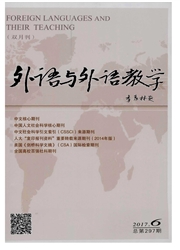

 中文摘要:
中文摘要:
针对解释熟语语义结构这一问题,不同学者提出过不同的解释模式。本文在认知语言学的理论框架下,以具有动宾结构的英语熟语以及双动宾结构的汉语四字格成语为语料,在国外学者提出的复合场境模式、棱镜模式和熟语激活模式的基础上,对熟语特性、语法地位、组构假设、语义结构混杂性等问题加以考察。这些模式能够为关于熟语语义加工理解的心理语言学和神经语言学研究提供理论方面的启示。作者综合这些模式,尝试对英汉熟语进行分类和个案对比分析,并指出这些模式在实证性研究方面的不足和今后研究的方向。
 英文摘要:
英文摘要:
Different explanatory models have been proposed on the semantic structure of idiomatic expressions. Under the theoretical framework of cognitive linguistics and through some English verbal idioms and some four-character Chinese idioms as the linguistic data,the present paper tries to elaborate on idiomatieity,grammatical status,compositional hypothesis and semantic structural heterogeneity of idioms on the basis of a brief review of the complex scene model, prismatic model and idiomatic activation-set put forward by some foreign linguists. These models provide some theoretical guidance on idiom semantic processing in the fields of psychohnguistics and neurolinguistics. By combining these models,this paper also classifies English and Chinese idioms into different types and makes a comparative case study. Finally,the paper points out the deficiency of empirical studies on these explanatory models and gives some suggestions for further studies.
 同期刊论文项目
同期刊论文项目
 同项目期刊论文
同项目期刊论文
 期刊信息
期刊信息
